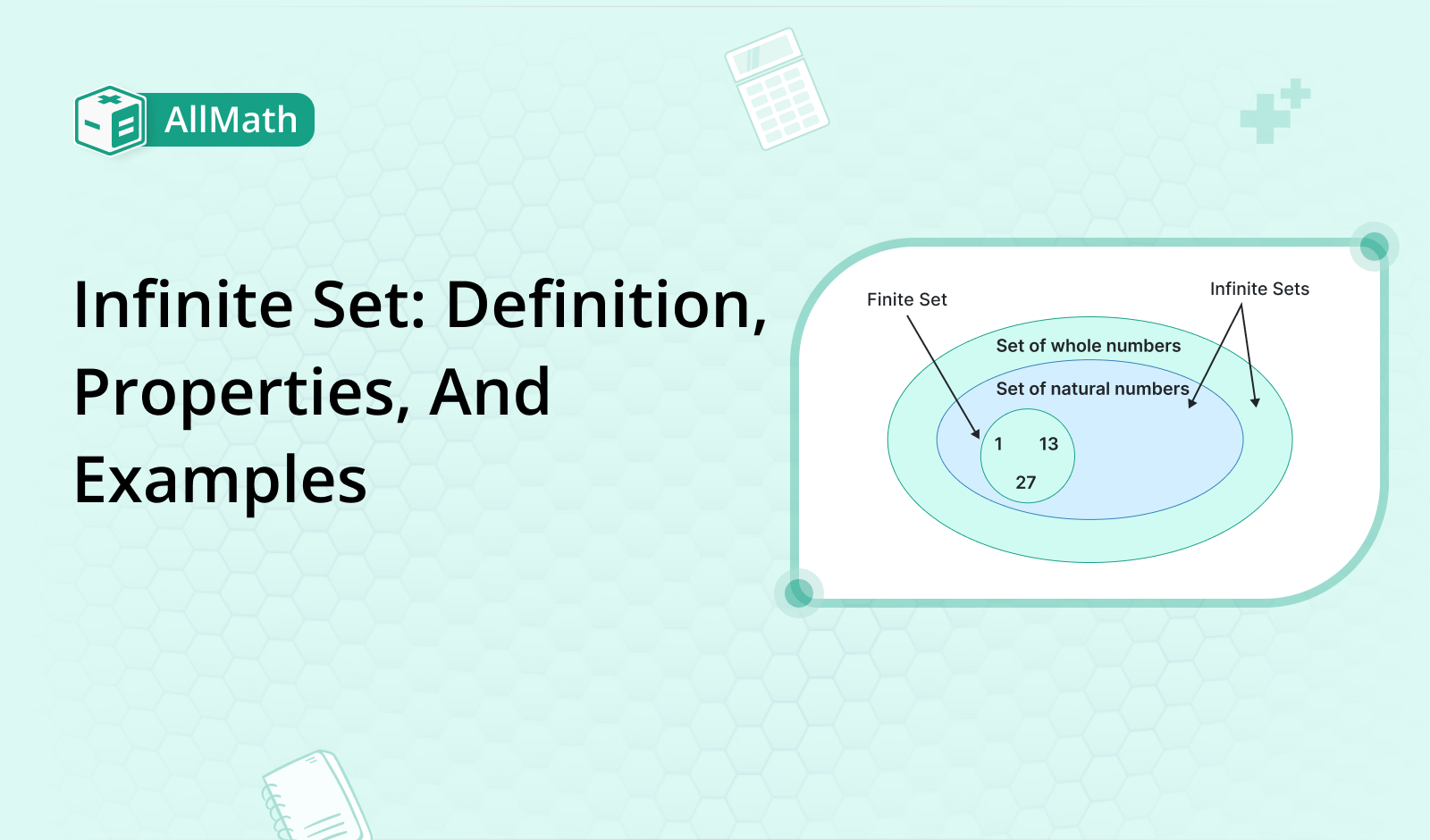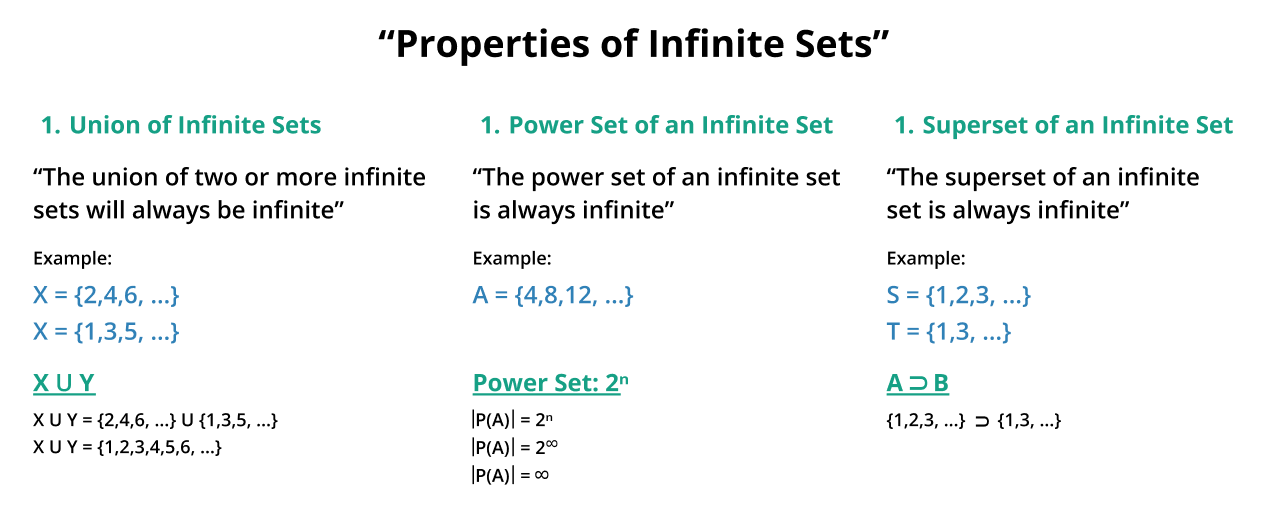To calculate result you have to disable your ad blocker first.
Infinite Set: Definition, Properties, and Examples

Publish Date: 04 Nov, 2023
Table of Content
A set is a group of different and clearly defined items. Each item in a set is known as an element of that set. Finite and infinite sets are common types of sets. A finite set has a limited or countable number of elements, like the set of the first ten natural numbers.
An infinite set contains an endless number of items, such as a set of even numbers. We’ll explore the basics of infinite sets in this blog. We’ll provide a comprehensive definition of an infinite set along with its properties, application, and examples.
What is an Infinite Set?
An infinite set is a type of set that has an infinite number of elements. The elements in an infinite set can’t be counted or listed completely. Infinite sets differ from finite sets, as they do not have a fixed number of elements.
Infinite sets can vary in size and may have more elements than others. However, they all share the common characteristic of being never-ending. Ellipses (...) in infinite sets indicate that the set continues infinitely.
Examples
- Set of Even numbers =
E = {2, 4, 6, 8, 10, …} - Set of integers =
Z = {... -3, -2, -1, 0, 1, 2, 3 ...}. - Set of odd numbers =
O = {1, 3, 5, 7, 9, …}
Types of Infinite Set
The infinite set has two following common types.
- Countably Infinite Set
- Uncountably Infinite Set
Countably Infinite Set
Countably infinite sets can be compared with a set of natural numbers in a one-to-one correspondence. This means that there is a way to pair up each element in the set with a unique natural number and no natural number can be matched with more than one element. The set of even numbers is an example of a countable infinite set.
Uncountably Infinite Set
Uncountably infinite sets cannot be put into a one-to-one correspondence (bijection) with the set of natural numbers. Some natural numbers are paired with more than one element in an uncountably infinite set. The set of complex numbers is an example of an uncountable infinite set.
What is the Cardinality of an infinite set?
Cardinality refers to the total number of elements that exist in a set. For an infinite set A, we denote its cardinality as n(A) = ∞, where n(A) indicates the number of elements in the set A and ∞ indicates that the number of elements is limitless and cannot be expressed as a finite number.
Properties of Infinite Set
- The union of infinite sets results in an infinite set.
- The superset of an infinite set always remains infinite.
- The power set of any infinite set is itself infinite.

Applications of Infinite Sets
Here are some notable applications of an infinite set.
Calculus and Analysis
Infinite Sets find extensive use in calculus and mathematical analysis. Particularly in studying limits, continuity, and the behavior of functions. Concepts like infinite series and sequences are crucial components of calculus that depend on Infinite Sets.
Probability Theory
Infinite Sets play a vital role in the study of continuous probability distributions. Probability distributions over infinite intervals often require a deep understanding of Infinite Sets.
Cryptography
Infinite Sets find applications in cryptography, where certain encryption techniques involve the manipulation of Infinite Sets to ensure the security and confidentiality of data.
Computer Science
In computer science, Infinite Sets are integral to the study of algorithms and computational complexity. Infinite Sets help analyze the efficiency and behavior of algorithms, particularly in cases where inputs are potentially unbounded.
Some Tips to identify an infinite set
You can use various techniques and strategies to identify whether a set is infinite. Here are some tips to help you determine if a set contains infinite elements.
- Observe the elements in the set and check if there is a repeating or growing pattern. If you notice that, the set extends indefinitely without any repetition and clear endpoint. It indicates that the set is infinite.
- Compare the element of the set with a known infinite set. Try to establish a
one-to-one correspondencebetween the given set and the set of natural numbers suggesting that the given set is infinite. - Investigate whether the given set has an infinite subset. The set will be infinite if you find an infinite subset.
- Some sets naturally lend themselves to infinitude. For example, the set of all real numbers between two distinct points. Such as
(0, 1)is infinite.
Examples of Infinite Set
Example:
Identify the infinite set from the following sets
- Number of days in a year
- {3, 6, 9,...}
- {8, 10, 12, 14}
- The set of Whole numbers
Solution:
- The set representing the number of days in a year is finite. Because a regular year consists of 365 days and a leap year has 366 days. Both these values are fixed and limited.
- The set continues indefinitely as there are infinitely many multiples of 3. Therefore, the set of multiple of 3 is infinite.
- The set
{8, 10, 12, and 14}is finite. Because it consists of four distinct values with no additional elements beyond these. - The set of whole numbers starts at 0 and includes all positive integers. It is represented as
W= {0, 1, 2, 3, 4, ...}. This set is infinite because it continues indefinitely without an upper bound.
Conclusion
In this article, we've discussed the definition of an infinite set in detail. We examined some important properties of an infinite set. We explored its types and applications. We learned some tips to identify the infinite set. We have looked at some examples of infinite sets.

